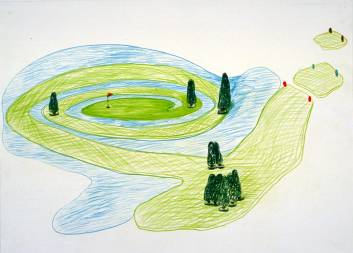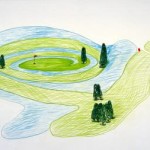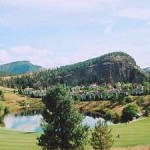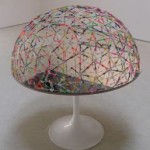By JENNIFER MCMACKON
JM: Lee Goreas, how did you become an artist?
LG: I became an artist by chance. A good friend enrolled me in an art program at a local college. After one year in the program I realized that art school was a place where I had access to a studio, tools, a community of peers and art history, so I stayed.
JM: Where did you go to school?
LG: I went to art schools in British Columbia and Ontario. I have a diploma from the Okanagan College in Kelowna, a BFA from the University of Victoria and an MFA from York University in Toronto.
JM: Which of your instructors would you say had the most impact on you as an artist?
LG: There were several influential instructors; Bryan Ryley, Lynda Gammon, Mowry Baden and Richard Suarez. I would say that Richard Suarez and Bryan Ryley had the greatest impact on me. Bryan Ryley helped me to realize that my ideas were valid and their success depended on my commitment to them. Richard Suarez helped me to realize that every aspect of one's life could be considered an art-full or creative act and that what you did outside of the studio and institution could become the content of your work. Lynda Gammon opened my eyes to the contemporary international art community
JM: What kind of work were you making or interested in making at that time? How did that evolve into your current practice? And just to put a finer point on it, (since Roberta Smith recently did) would you call your life in the arts a 'practice'? How do you refer to what goes on in the studio?
LG: At that time I was interested in making drawings and sculptures. I was experimenting - trying to combine the two mediums. This eventually evolved into a proliferation of objects where I tried to unite drawing, sculpture and painting.
I don't know how successful the objects were but working in a variety of mediums and trying to merge them into one object was a very valuable process for me to go through. It greatly effected my definition of what constituted a work of art. My interest in the fusion of a variety of mediums evolved into my current production slowly and through a separation of the mediums. Now I make drawings and sculptures, but I no longer try and combine them to make one object. I am still making drawings and sculptures. I do not know if I would call my life in the arts a practiceÉ. I guess you could call it a practice, I like to think of it as work. When I am in the studio and I am trying to realize my ideas I always feel like I am going to work. Most of the time I really enjoy my work but some days I don't.
JM: You also take photographs don't you? And you make videos too?
LG: Yes, I do take/make photographs and I work with video also. I find both of these mediums difficult. It's easy to convince oneself that they are easy compared to sculpture painting or drawing but they are not. I really started taking serious photographs and videos about 10 years ago.
JM: It is often assumed artists have a direct line to the imagination - that the feed between mundane affairs and subjectivity is always wide open. How do you cultivate your imaginary life?
LG: I don't think only artists have a direct line to the imagination. I would say from a lot of recent work I have seen, I do not know if artists are using their imagination that often.
How do I cultivate my imaginary life? I cultivate it or exercise it through actively being engaged in the popular culture that surrounds me, film, literature, sport, and art history.
I try to use my imagination daily. When I was as a younger artist I tried to write a definition of what I thought the imagination was. I came up with "The simultaneous act of making and thinking". I think this is still true for me today, when I am simultaneously making and thinking in the studio I feel that I am somehow accessing and using my imagination.
JM: Do you keep notebooks?
LG: Yes. I have been keeping notebooks since my first year of college in 1984. I could never wrap my head around the idea of the artist sketchbook so I had to find a type of book that suited my idea of what a notebook should be. I found that a science lab book worked best. On one side of the book the pages were lined and on the other side the pages were graph paper. The idea of a book that was used for experiments, research, diagrams a place for text and images really fueled my imagination. I actually just started a new one about a month ago.
JM: Is that (in your notebooks) where you developed the strange and heady admixture of road trip and golf game commingled with the movement of the planets that we so often come across in your installations? Like the one you did at YYZ ten years ago? Or the massive projects you did at Open Space in Victoria, or Southern Exposure in San Francisco?
LG: It comes naturally I think. I have always played with text without really meaning to. My texts usually occur in a stream of consciousness or a free associative manner. They're like punch lines for mundane jokes that have not been written yet or familiar sayings but you can't remember who said them or when they were said. Sometimes the texts are taken from a title of one of my drawings, sculptures or videos. I think of my process when working with language as creative misspelling. They usually occur in less than 30 seconds sometimes a minute, I've tried working and reworking some of them for days at a time but it's usually that first quick original draft that is most humorous and in the end the right one.
JM: Can you talk a bit about the role golf is playing in your work?
LG: Golf has been playing an important role in my work for almost 3 years now. I'm interested in the landscape and design of golf course holes. Golf course landscapes are really quite surreal and absurd. They almost seem UTOPIAN Ð perfect, manicured environments complete with miniature trees, small lakes and rivers, perfectly cut grass and small sandy beaches. The sculptural qualities of golf courses really started influence my photographs and drawings. I started taking photographs of the courses first and then later started to make drawings of them. This rekindled my interest in sculpture and I got to thinking about historical sculptures that I liked. Then one day in the studio I thought of a golf course that had historical canonical sculptures integrated into it as hazards a golfer would have to contend with like a sand trap or a stream. That became the basis for my most recent body of work, which I am still working on. I showed some drawings from this work for the first time this past summer at Birch Libralato.
JM: It was great fun to watch viewers approach your drawings at your opening - funny little conversations would break out between people who knew the works you depict in your golf hole drawings and those who were less sure of what they were looking at.... Is your sculpture canon hard and fast? How many golf course holes will it take to accommodate the whole canon?
LG: No the canon is not hard and fast. It would probably take about three, eighteen hole golf courses and maybe one nine hole course.
JM: I really enjoyed, the mirrored , geodesic half dome sculpture in the show at Birch Libralato. How did that come together?
LG: The sculpture you are referring to is entitled Hemisphere. It came about over the course of 10 months of almost non-stop failures. I was obsessed with the idea of making this Buckminster Fuller geodesic dome out of colored golf tees. I kept convincing myself that I knew how to make a geodesic dome with out really knowing how. It was an intense exercise of trial and error. Then one day an artist friend of mine, James Carl said, "If you are going to make a dome you have to start from the ground up." I had been trying to work from the top down to the ground. I finally made it work but not without a lot of sweat and elbow grease. The Aero Saarinen pedestal base with quarter inch mirror tabletop were both after thoughts. They occurred once I started to think of how to present the dome. The table base and mirror top really helped to push the modernist and futurist aspects of the sculpture.
JM: So who do you think is the most interesting visual artist of our time?
LG: Chris Burden
JM: Which artist you would you most like to meet if you could be transported backward in time?
LG: Caravaggio
JM: Have you ever had really good art envy? Have you ever seen a work of art by another artist you wish you made yourself?
\LG: Yes, The 1969 painting by Philip Guston entitled "Riding Around"
JM: What is your favorite work of art in all of art history?
LG: Spiral Jetty
JM: Who, would you say is the most artistic golfer on the pro circuit?
LG: Jasper Parnevik
- Lee Goreas, Smithson Hole, Pencil crayon on paper, 2006
- Lee Goreas, C print, edition of 5, from the ‘PINNACLE’ series 2007
- Lee Goreas, Hemisphere,, 840 multi colored 2.5-inch golf tees constructed into the shape of a geodesic dome placed upon a mirrored tabletop and white powdercoated metal pedestal table base. 2007
All images are courtesy of the artist.
[Note: This piece was published in this issue 4 hours after the initial launch of #75]







